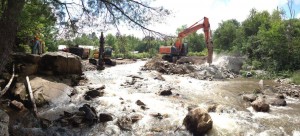 From American Rivers:
From American Rivers:
Communities in 19 states, working in partnership with non-profit organizations and state and federal agencies, removed 72 dams in 2014, restoring more than 730 miles of streams for the benefit of fish, wildlife, and people. California, Colorado, Connecticut, Delaware, Iowa, Idaho, Illinois, Maine, Massachusetts, Michigan, New Hampshire, New Jersey, Ohio, Oregon, Pennsylvania, Tennessee, Vermont, Virginia, and Wisconsin are represented on the list.
Pennsylvania topped the list for the twelfth year in a row. The top three states for river restoration through dam removal in 2014 are:
Pennsylvania – 17 dams removed
California – 12 dams removed
Michigan– 6 dams removed
Ohio, Massachusetts, and Iowa each had five dams removed in 2014.
Looking ahead to this year, American Rivers set a goal of 75 dam removals. Scheduled dam removals include the West Brittania Dam on the Mill River in Massachusetts and the Fielder and Wimer dams on Evans Creek, a tributary to the Rogue River in Oregon. Removal of the Plymco Dam on Town Creek in Plymouth, Massachusetts began just last week.
“The river restoration movement in our country is stronger than ever. Communities nationwide are removing dams because they recognize that a healthy, free-flowing river is a tremendous asset,” said Bob Irvin, President of American Rivers.
American Rivers will add the information on the 72 dam removals in 2014 to its database of more than 1,185 dams that have been removed across the country since 1912.
Most of those dams (971) were removed in the past 20 years. American Rivers is the only organization maintaining a record of dam removals in the United States and uses the information to communicate the benefits of dam removal, which include restoring river health and clean water, revitalizing fish and wildlife, improving public safety and recreation, and enhancing local economies. American Rivers played a role in 20 of the dam removals on this year’s list. This list includes all known dam removals, regardless of the level of American Rivers’ involvement.
American Rivers updated its interactive river restoration map to include the 2014 dam removals. The map includes all known dam removals in the United States as far back as 1936. The map features the name of the dam and river, location, year the dam was removed, as well as other interesting facts. Explore the map at www.AmericanRivers.org/DamRemovalsMap
Highlights of dam removal and river restoration efforts in 2014 include:
Byrnes Mill Dam, White Clay Creek, Delaware
The University of Delaware Water Resources Agency, in partnership with American Rivers, NOAA and others, made history in late 2014 with the first recorded dam removal in the State of Delaware. The Byrnes Mill Dam, also known as White Clay Creek Dam No. 1, on White Clay Creek was removed to allow for fish passage. The removal reconnects 3.5 miles of habitat for migratory and resident fish in the White Clay Creek National Wild and Scenic River to the tidal Christina and Delaware rivers and is the first of several anticipated removals along this stretch of river. Read more about this project.
Harvell Dam, Appomattox River, Virginia
Harvell Dam, the first blockage on the Appomattox River, was successfully removed in July 2014, reconnecting 126.5 miles of habitat for resident and migratory fish. Built around 1890, this concrete structure was designed first for mills and navigational purposes, and later used for hydropower. Fish passage installed in 1998 proved inadequate. The Virginia Department of Game and Inland Fisheries and its partners worked with the dam’s owner and the local community of Petersburg to ensure expanded access to critical spawning and rearing habitat for species including American Shad, and to enhance opportunities for recreational boating and fishing. Read more about this project.
Dams #1 and #2, Des Plaines River, Illinois
The Forest Preserve District of Cook County removed two dams on the Des Plaines River in 2014 and reconnected nine miles of river for fish and recreational users. These roughly five-foot tall dams were owned by FPCC and removed as part of a broader restoration effort that will eventually involve removal of five additional dams between Wisconsin and Joliet, Illinois. Restoration of the Des Plaines River began in 2010 with the removal of the Ryerson Woods Dam. Since then, a total of six dams have been removed.



